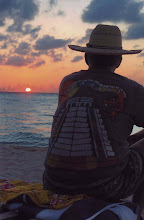Lay a yard stick down
pointing north /south, and drive 60 miles at 75 miles per hour through the
desert, perfectly straight, and you will arrive at the mesas. No gas
stations, no restaurants, no rest stops, very few cars. No road signs and it is over
100 degrees. No one is hitchhiking. One day it hits 112 degrees. You cannot
make this stuff up.
We are not in
Massachusetts anymore. I can tell by looking around, and by the road signs.
Here there are buttes and washes and mesas and draws and even gulches. The language is so different out here in the southwest. "Do you
want your purchases in a sack?" You bet.
Cliff edge houses seem
to grow out of the terrain abruptly from the flat desert and blend into the
earth. There are three mesas with only twelve villages. First Mesa,
Second Mesa and Third Mesa. All over 1,000 years old.
Second Mesa, which we choose to explore, was settled by the Bear Clan. Television antennae, satellite dishes, and automobiles notwithstanding, these Hopi villages still exude the air of another time. Most of the houses are made of adobe and stone.
Second Mesa, which we choose to explore, was settled by the Bear Clan. Television antennae, satellite dishes, and automobiles notwithstanding, these Hopi villages still exude the air of another time. Most of the houses are made of adobe and stone.
 |
| This hairstyle indicates that a Hopi woman is available to marry. |
 |
| Hopi snake dancer |
Kezia did not like the idea of driving into the villages. “What if someone drove into where we live and parked and gawked and stared and took photos," she proclaimed.
The first time we came here, a
car in a cloud of dust drove up behind us. The driver hurriedly got out and asked, “Parlez-vous Francais?" which blew our minds. A French tourist deep
into the Arizona desert.
To make it worse for
Kezia, she had to pee. I stopped, not knowing where to turn next. The dirt roads
are extremely steep and dangerous. The mesas are no place for acrophobes. That
is why the Hopi chose to live here.
Believe it or not, Hopi children are
playing with bows and arrows. Are they playing Cowboys and Indians? Indians and Indians?
You can
see in every direction for miles if an enemy is coming. The Hopi were farmers
and peaceful, but their mesas are like islands in the largest reservation
in the United States -- the Navajo Nation. And to the south were the
dangerous Apache.
Anyway a Hopi boy walks up to our rental car and asks us what
we need. He suggests using the bathroom of his uncle, right behind us. Four
white people walk towards the house. Yes we can use their bathroom. Immediately
the family brings out their wares that they have for sale. They are a little
like the Mexican storefront owners on Isla. Show interest in one piece, and get
an hour's explanation of how it was made, what it means, and finally what it
costs.
There are two daughters here. One is pregnant. She tells us she is
looking forward to the birth, but not the Hopi ritual of sitting in the hot sun
for twenty days and eating only corn and drinking water (following the birth).
They still collect eagle feathers, which they say make the rains come. You
know what? It isn’t working. This place is dry as a bone. Rick Steves on
his television travel show says mix with the locals. Did we ever!
The father who looks
very Alaskan has three kachinas that
he has made and are for sale at very reasonable prices.
They generally run from
$400 to $1,000 dollars. The Navajo make them also, out of cottonwood, but the
Hopi’s are worlds better.
Years ago I bought a Navajo Kachina in the bottom of Canyon
de Chelly, in Chinle, just east of where we are now, for $35. The
town Chinle, in Navajo, means where the water comes out. It is nice, but the
others that we purchased in Sante Fe and Flagstaff are beautiful and museum-worthy.
The kachina that I like -- I own four now, doesn’t everyone? -- is not completely painted. It is
white with a turquoise-ish face. He tells me it is painted with white clay from
the desert. I fail to ask him where he gets the other colors. There will
be seven colors in mine.
The closest town is far away, in -- believe it or not --
a place called Tuba City. He says he will finish painting it and I can
come back to see if I still want to purchase it.
I am stuck. We are at his
home. We used his bathroom and his time.
We go back in an hour. I love it, and
purchase it. Each feature was painted for a reason he explains in great detail.
Each color was painted for some ancient reason. Kezia notices that it has
a yellow shirt. That day I am wearing a yellow shirt. Kezia feels it is not an
accident that he chose the yellow. Amarillo.
Lizard Katsina
Hopi 2016
Clint Lucas
Second
Mesa
You do not have to
leave our country by way of a large ocean to feel as though you are in a
foreign country. See America first.







No comments:
Post a Comment